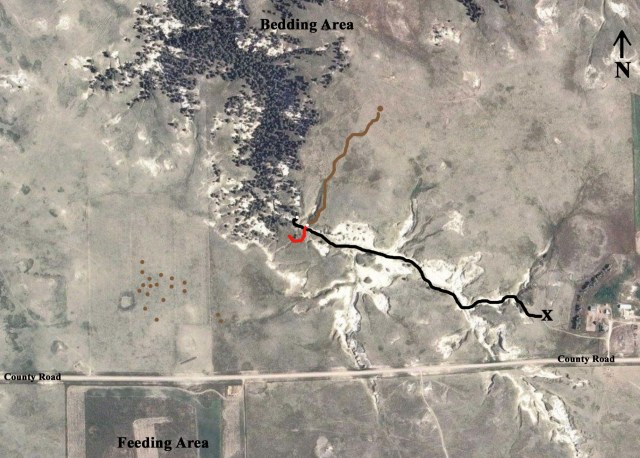Spot, Stalk, and Wait: A Hunting Story
Adventurous Bowhunter 09.27.12

I consider myself very lucky to have grown up in a ranching family, and there isn’t much that enjoy more than spending time on my parents cattle ranch in eastern Wyoming. We are lucky to be in an area that has abundant wildlife including whitetail and mule deer, elk, pronghorn antelope, turkeys and lots of other small game. Mule deer being my favorite big game animal, I have taken a special interest in the ones on the ranch. When we first acquired the ranch the deer herd had been hunted heavily in the past and there was hardly any age structure. We knew that if we wanted to have some larger deer on the property we would have to let them get older. We decided to harvest mature deer only, and we figured that meant a mule deer that was 4.5 years old or older.
To help improve the quality of deer I also tried to plant some food plots. This didn’t work out so well as it is a pretty dry climate, an average of about 15 inches of rain per year, and the stuff I planted didn’t grow very well. Luckily there are dryland hay fields that have alfalfa in them that provide the deer with nutrition so I gave up on food plots and focused strictly on age for the first several years. Now that there are several deer around 5 years old on the property and plenty of ones younger to take their place in future years I have decided to start working on the genetics part of the management by culling out older bucks that aren’t as big as I would like. This may be a lost cause since most of the neighboring properties aren’t practicing the same deer management that we are, but I have to try.
The above picture was taken in early July while scouting and shows two management bucks; the one on the left and the one-third from the left. The buck second from the left is exactly the type of buck that I want to see more of. The reason the two mentioned are management bucks is because they are both mature and just haven’t grown quite big enough antlers. The one is a 2×3 and the other is a 3×4, and I would like to have 4x4s or better. I wouldn’t consider the buck on the right as a management buck since I think he is only 3 years old, and he may grow significantly from this year to next.
When I returned home from my Colorado deer hunt I did a little scouting to make sure the deer were still on their summer patterns. I confirmed that they were, and also that some of the bucks had already lost their velvet, a sign that things were about to start changing.
I hunted a few different days without getting a shot. I wasn’t too worried about it as I knew that I just had to be patient and not push the deer too much. I have found one of the best ways to hunt these deer is to intercept them going from where they bed to where they feed. This means hunting early in the morning or in the evenings. On September 7th I was late getting out and as I drove towards where I wanted to go I spotted a group of deer already out in the pasture. I looked at them through my binoculars and confirmed that it was the group of bucks and few does (brown dots). There is a picture below that diagrams my hunt and I will use it to show what happened.
I kept driving down the road and then spotted a deer in a different spot that was headed towards the other deer (brown dot and line). I looked at him and confirmed that it was a deer I wanted to harvest, and since there was no way to stalk the others I decided to go after him. I parked my vehicle (black X) and started my stalk. I got down in a draw that would put me out of sight of all the deer and hurried to where I thought the buck would travel (black line). I was able to peek up out of the draw to confirm the deer was headed my way. From past experience I had a good idea of exactly where the buck would travel so I sat underneath a pine tree that was 35 yards from the trail. Now all I had to do was wait, which was pretty hard. I kept wanting to get up and make sure the deer was still coming, but I just had to trust my gut and sit there until dark or he came by. He popped out at 60 yards and stood there looking down into the draw where I was. After about a minute he felt comfortable and dropped down onto the trail I had hoped he would. As he walked by becoming broadside I was able to draw my bow without him noticing. He was still walking so I let out a soft grunt to stop him (white dots). I took the shot and the arrow zipped through both lungs and then stuck in the dirt bank behind him. He then ran about 75 yards (red line) when he then stopped and tipped over dead.
I saw and knew the buck was down so I hurried back to my pickup to get my camera and also drive to my buck to load him up. This is the first deer in several years that I have actually been able to drive to, and I had to almost re-learn how to gut a deer since I wasn’t going to bone this one out.
-Ethan Starck








